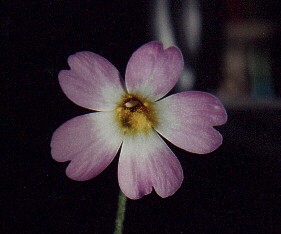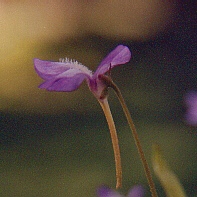Pinguicula moranensis
This species, the most common in culture, grows well in a substrate consisting of 50% peat and 50% fine quartz sand. In summer soil should be kept wet. Temperatures should be in a range between 20-30° C. Humidty is best above 60%. Therefore it will be best if you place the pots in a tray filled with water up to 1 cm high. When water in the tray has disappeared, wait some days before you refill, so that the roots will get enough oxygen. In autumn you should reduce watering. In winter the substrate can get bone-dry. Once a month you can water the plants, so that the substrate only is getting humid (not completely wet). Temperatures in winter are good between 10° and 15° C. A good aeration of the plants is needed all the year round to avoid rotting of the plants.
This cultural information is also suitable for Mexican butterworts from mountainous regions, forming carnivorous summer leaves and succulent non-carnivorous winter leaves.
Pinguicula emarginata
This tropical species from Mexico forms only one set of carnivorous leaves. Allthough P. emarginata grows on vertical sandstone cliffs together with a blue algae, the use of 20% peat together with 80% fine quartz sand as substrate shows good results. Humidity should not be lower than 60%, because this species lives in humid valleys, where temperatures do not fall below 20° C in winter, while in summer temperatures can reach 30° C. The soil should be kept all the year wet. When you keep the plants in trays filled with water, as described for P. moranensis, let the trays dry out for 1 or 2 days once a month, so the roots will not suffer from a lack of oxygen. If your cultivation conditions are well, P. emarginata will flower all the time.

Pinguicula primuliflora
This species, native to swampy regions in the Southeastern USA, should be cultivated in pure peat or peat mixed with sphagnum moss. In summer the plants require a wet soil, temperatures at about 25° to 30° C, high humidity and a lot of light, so I keep the plants in a terrarium outside in a semi-shaded place. In winter in its native habitat temperatures are cooler and the soil is less wet. The plants reduce growth in winter, so I cultivate P. primuliflora at temperatures which range from 10° to 15° C and I keep the soil only moist. I have observed that the plants do flower in winter and one time in summer under these conditions.
With the same cultural method I cultivate successfully all other Pinguicula species of the Southeastern USA. But you have to notice, that P. primuliflora, P. planifolia and P. caerulea do love more wet condtions, while P. lutea, P. pumila and P. ionantha do grow in more sandy habitats under less wet conditions (especially the habitat of P. pumila is hot and dry in summer). You can also grow the European butterwort P. lusitanica under the above mentioned conditions. A good aeration is especially necessary for this group of plants to avoid the rotting of the plants.
Pinguicula vulgaris
This butterwort distributed in temeperate regions on the Northern hemisphere grows in poor soil often with high contents of organic mass. Cultivation is only possible outside. The plants prefer summer temperatures not above 25° C, a wet soil and high humidity. I cultivate this species in pure peat, the pots placed in trays all the time filled with water in semi-shade. In autumn P. vulgaris do form a winter bud (hibernaculum) to overwinter the unfavorable climatic conditions. Generally you can overwinter the plants outside, when the plants are protected enough against severe frosts (cultivation method to prefer). If you live in a region, where temperatures in winter can be above 3° C for a longer period, there is a risk that the plants do form new leaves and will die when temperatures getting lower again.
So you can keep the winter buds together with living sphagnum moss in a closed plastic bag in a refrigerator. I treat the winter buds with a fungicide to protect them against fungus attack. In March (when temperatures do not fall anymore below 0° C during the night) you can repot the winter buds and place them outside.
This cultural method also fits for all other temperate species growing in the Northern hemisphere in acid soils (for example bogs and swamps). Notice that especially species living in mountainous regions are very sensitive to high summer temperatures (above 20° C for a longer period) and low humidity.

Pinguicula vallisneriifolia
This temperate species, endemic to several mountain ranges in Southern Spain lives on vertical limestone cliffs, where water is running down and keeping the rock moist and humidity high. You can cultivate P. vallisneriifolia in pots using a soil that drains well. I use as substrate a calcerous soil mixed with a little peat. Beside the different soil I cultivate this species like P. vulgaris, already described above.
This cultivation method also fits for all other temeperate butteworts occuring on limestone soils.
Subject "water":
Generally butterwort species are not so sensitive to the use of tap water. But you should find out if your local water does not contain a high amount of chlorine. The best way is to use rain water. When you collect your rain water from a roof, be aware that the water does not have to much algae washed from the roof together with the water.